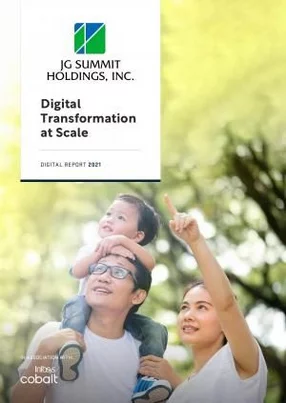Effecting a successful digital transformation is a challenging prospect, regardless of the scale of your enterprise or the complexity of its operations. Some digital transformations, however, are undoubtedly an even more delicate balancing act - between cost, complexity, sustainability, and scale - than others.
For Carlos Santos, Group Chief Information Officer at JG Summit Holdings, executing on the digital transformation goals of one of Southeast Asia’s biggest, most diverse conglomerates, represents a herculean endeavour. Santos, however, takes a brighter view of things. “We have investments across the banking, real estate, airline, food and petrochemical manufacturing, retail, and digital media sectors. We touch the lives of almost every Filipino,” he explains to me. “Typically, if you're working for a large-scale conglomerate, you're working in just one industry. At JG Summit, you're working across multiple business units in lots of different verticals. There are a lot of differences between the IT services at an airline compared to a retail organisation or a bank, so it's very exciting.”
Overseeing the IT operations for a multi-billion dollar holdings conglomerate with assets in industries ranging from petrochemical manufacturing to retail and banking is, Santos admits, an exercise in managing complexity. “It's very complex as well because there's no one-size-fits-all solution. You have to be adaptable,” he says. While creating an overarching, group-level digital transformation strategy for a range of business units with diverse and individual needs might initially seem like a mutually exclusive set of goals, Santos explains that in reality it’s about striking “a very delicate balance. At the end of the day, the corporate function needs to support the business units, not the other way around.”
Managing Complexity at Scale
In order to manage the complexity of implementing a digital transformation strategy across an organisation with the scale and diversity of JG Summit Holdings, Santos notes that there are “few things I think are really important.” First, finding the right partners is essential, both internally and externally.
“You have to partner with the right people, especially the CEOs, CIOs, and CFOs in our individual business units, to really identify where we can create synergies within the group as a whole,” he says. “Driving digital transformation has to be a collaborative process. I can't just tell all my CIOs that we're going to be implementing X platform - it doesn't work. We need to work together to figure out what's best for each business unit and how those business units can work together to create the synergies that I mentioned.”
Finding the right partners externally is also “very key” for Santos. “When I came into this role, I knew that there were a lot of things to be done, and I'm humble enough to say that we don't have the capability and capacity to be able to do them alone,” he reflects, continuing that, for him, “partnering means a win-win - not like a vendor/supplier relationship. I am very keen to partner because I know that, from a capability point of view, we don't have everything we need to succeed by ourselves at the speeds we need. If I didn't have the partners that I work with, I wouldn't be able to do all the things that I need to do.” In order to ensure successful partnerships, Santos exposes his strategic partners to “the highest levels of JG Summit’s management,” holding top-to-top discussions between the heads of JG Summit’s partners and the conglomerate’s chairman and CEO to best identify the areas where innovation and synergies can be pursued.
Infosys: Partnering for Success
Infosys and JG Summit Holdings have partnered on three key projects so far, the latest being the company’s data centre migration and consolidation. “We had an eight month bidding process in the latter part of 2018 through to 2019, and Infosys won the right to move our whole data centre architecture to the cloud, both public and private,” says Santos.
As a result of Infosys’ expertise, and by leveraging the scale of JG Summit, the project - which migrated a disparate data centre architecture spread across multiple business units into a single, unified, cloud-based solution - “we were able to reduce cost, which also passed those reductions along to the individual business units,” Santos explains. “If you're a business unit and you do a data centre migration alone, you're going to pay more than if you do it as part of the group.”
Serving the Business
Digital transformation for the sake of digital transformation, Santos explains, will never be as effective as a strategy driven by a desire to solve concrete pain points for the business and drive efficiency, as well as cost reductions. In order to be successful, he continues, it’s vital to “really interrogate why we as a group exist.”
Santos notes that “We exist as a group because of scale, and the value of what that means is mostly related to cost. But one of the other benefits of doing digital transformation across the whole group is that you're able to do things faster because you're able to leverage a bigger pool of knowledge and expertise.” Since his arrival at JG Summit Holdings four years ago, Santos has implemented a unified communications platform across the entire business - something that, he adds, was instrumental in JG Summit’s efforts to weather the COVID-19 crisis last year. “Our employees are now able to collaborate virtually. We moved people away from Microsoft Office to adopt a full suite of Microsoft collaboration tools. Even Microsoft has lauded how quickly we were able to implement that transformation,” he says. “We're definitely a leader in terms of cloud adoption in the Philippines.”
Now, Santos is taking a similar approach to pan-organisational analytics. “We spearheaded training in order to get people comfortable with using analytics dashboards and reports. We've started to ingrain these analytics into each of our business units, and are now using them as part of their day to day operations and strategy,” he says.
Santos and his team’s drive to identify common needs between different business units is also allowing various JG Summit’s different business units to digitally transform their ERP capabilities faster and more successfully than organisations half their size - and with significantly less complexity. “We're already one of the few players in our market that is already in the process of fully upgrading to SAP S/4 HANA,” he says. “We've already transitioned four out of eight business units to S/4 HANA, and we're already ahead of where we wanted to be in terms of our roadmap. I expect that, in the next few years, we'll successfully complete the transition for all of our business units. It's something that the team is very proud of.”
The Road Ahead
Santos and his team have made incredible progress over the past few years, leaving JG Summit Holdings far better prepared to meet the challenges and seize the opportunities the future holds. However, there is still work to be done, and Santos is quick to point out that past successes are no justification for the department to rest on its laurels. “Because of the diversity and scale of all our business units, I can't afford to lose any time embracing digital transformation.”
From sustainability - where JG Summit is embracing a rigorous ESG roadmap in order to “operate in line with the United Nations' climate goals” - to continuing change management, Santos is continuing to press ahead with his goal of creating synergies and implementing new strategies and solutions across JG Summit Holdings. “Tech is an enabler rather than the primary solution. Technology always needs to be looked at in terms of its ability to solve a problem for the business,” he reflects. “Once you really embrace that mindset, it really helps you understand what you're doing and why you're doing it. You start asking the right questions and getting more valuable answers. Once you've grounded your approach in finding solutions to business problems, technological advancements abound.”


